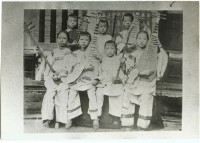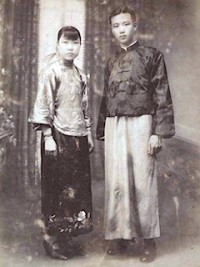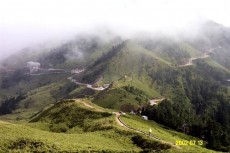|
Fading Into Insignificance After the Songs Were Sung—The Taiwanese Geishas |
|
 The word “geishas” often calls to mind prostitutes paid to engage in sex with clients. However, the traditional geisha profession was purely for entertainment. Geishas had to study poetry, literature, and traditional songs at a young age. They were expected to compose poems and sing songs with clients, so the success of their career depended entirely on their artistic and social skills. Not every girl could become a successful geisha, and not every client could afford the service of a geisha. If a client wanted to begin a sexual relationship with a gifted geisha, he had to pay her a number of visits and wait until a friendship developed between them. Only then would she agree to embrace a more intimate intercourse. It was not until the decline of the geisha industry that girls began to sell sex.
The word “geishas” often calls to mind prostitutes paid to engage in sex with clients. However, the traditional geisha profession was purely for entertainment. Geishas had to study poetry, literature, and traditional songs at a young age. They were expected to compose poems and sing songs with clients, so the success of their career depended entirely on their artistic and social skills. Not every girl could become a successful geisha, and not every client could afford the service of a geisha. If a client wanted to begin a sexual relationship with a gifted geisha, he had to pay her a number of visits and wait until a friendship developed between them. Only then would she agree to embrace a more intimate intercourse. It was not until the decline of the geisha industry that girls began to sell sex.
|
|
Read more...
|
|
Clothing Styles in Taipei in the 1930s |
|
 Taipei City, a relative latecomer in the urbanization history of Taiwan, began its development first in Monga and then in Dadaocheng. After the establishment of the new Taipei Prefecture in the late Qing Dynasty, walls were erected to mark the circumference of Taipei City, which, together with Monga and Dadaocheng were known as the Streets of Three Towns. After the Japanese takeover, Taipei City came under the shrewd management of the Japanese colonial government. In the 1930s, it was basking in the glory of booming industries and commercial activities. As the political and economic hub of Taiwan, and with infrastructure and urban development well ahead of several second-class cities in China and Japan, Taipei City was famous as the “Island Capital. Taipei City, a relative latecomer in the urbanization history of Taiwan, began its development first in Monga and then in Dadaocheng. After the establishment of the new Taipei Prefecture in the late Qing Dynasty, walls were erected to mark the circumference of Taipei City, which, together with Monga and Dadaocheng were known as the Streets of Three Towns. After the Japanese takeover, Taipei City came under the shrewd management of the Japanese colonial government. In the 1930s, it was basking in the glory of booming industries and commercial activities. As the political and economic hub of Taiwan, and with infrastructure and urban development well ahead of several second-class cities in China and Japan, Taipei City was famous as the “Island Capital.
|
|
Read more...
|
|
A Portrait of Taiwanese Figures in the Japanese Colonial Period |
|
 Lai He, born on May 28, 1894 in Changhua city, was formerly known as “Lai He” — the same name in English but representing a different meaning in Chinese characters. His original “He” means “river,” while the later “He” means “peace.” He also used many pennames, such as Lan Yun, Fu San, An Dousheng, Hui, and Zou Jiexian. He founded the Lai He Hospital in Changhua at the age of 23. He didn’t practice medicine to get rich; his sympathy for the poor results in his giving free or inexpensive care to low-income households. His first Chinese novel, notable for being written in the vernacular, was named “Dou Nay Nr” and was published in the Taiwan People’s Newspaper in 1926. The novel incorporates the use of dialect and slang, which adds a strong local flavor to the story.
Lai He, born on May 28, 1894 in Changhua city, was formerly known as “Lai He” — the same name in English but representing a different meaning in Chinese characters. His original “He” means “river,” while the later “He” means “peace.” He also used many pennames, such as Lan Yun, Fu San, An Dousheng, Hui, and Zou Jiexian. He founded the Lai He Hospital in Changhua at the age of 23. He didn’t practice medicine to get rich; his sympathy for the poor results in his giving free or inexpensive care to low-income households. His first Chinese novel, notable for being written in the vernacular, was named “Dou Nay Nr” and was published in the Taiwan People’s Newspaper in 1926. The novel incorporates the use of dialect and slang, which adds a strong local flavor to the story.
|
|
Read more...
|
|
Prehistoric Lapita Pottery in the Pacific |
|
 Based on archeological evidence, the Lapita Culture Complex spread over an extensive area of islands, stretching through the Bismarck Archipelago of Papua New Guinea, the Solomon Islands, the Vanuatu Islands, New Caledonia, and eastward to Fiji, Tonga, and Samoa, between 3,600 to 2,500 years ago. Artifacts found in the area include dentate-stamped pottery, stone and shell tools, shell decorations, and items used for trade. Archaeologists believe the economy of the Lapita was primarily marine-based, though agriculture could have also played an important role.
Based on archeological evidence, the Lapita Culture Complex spread over an extensive area of islands, stretching through the Bismarck Archipelago of Papua New Guinea, the Solomon Islands, the Vanuatu Islands, New Caledonia, and eastward to Fiji, Tonga, and Samoa, between 3,600 to 2,500 years ago. Artifacts found in the area include dentate-stamped pottery, stone and shell tools, shell decorations, and items used for trade. Archaeologists believe the economy of the Lapita was primarily marine-based, though agriculture could have also played an important role.
|
|
Read more...
|
|
Kinmen: Old Place, New Culture |
|
 The river of memory runs through battle trenches. Kinmen, as an impregnable battle field, always exudes an air of fortitude and courage; however, it also overflows with details of tenderness. The camera lens recorded the Kinmen people celebrating the birthday of Cheng-Huang God (City God) on April 12 (lunar calendar), the fire-scarred Wind Lion God guarding this strong but repeatedly battered island, as well as the fishermen facing the ever-changing sky and unpredictable catch. ......
The river of memory runs through battle trenches. Kinmen, as an impregnable battle field, always exudes an air of fortitude and courage; however, it also overflows with details of tenderness. The camera lens recorded the Kinmen people celebrating the birthday of Cheng-Huang God (City God) on April 12 (lunar calendar), the fire-scarred Wind Lion God guarding this strong but repeatedly battered island, as well as the fishermen facing the ever-changing sky and unpredictable catch. ......
|
|
Read more...
|
|
|
Mountains and Men of Taiwan |
|
 Whether they are Pa-tung-kuan Ancient Trail (八通關古道) or Mt. He-Huan (合歡山), Mt. Tai-Wu (太武山) or Mt. Chi-Lai (奇萊山), Mt. Pin-Tian (品田山) or Mt. Xue (雪山), the sceneries of their peaks or hillsides are all worthy of taking a picture or two. From the north to the south and from the east to the west, even to the outlying island of Kinmen, the mountains of Taiwan are near us wherever we are. ......
Whether they are Pa-tung-kuan Ancient Trail (八通關古道) or Mt. He-Huan (合歡山), Mt. Tai-Wu (太武山) or Mt. Chi-Lai (奇萊山), Mt. Pin-Tian (品田山) or Mt. Xue (雪山), the sceneries of their peaks or hillsides are all worthy of taking a picture or two. From the north to the south and from the east to the west, even to the outlying island of Kinmen, the mountains of Taiwan are near us wherever we are. ......
|
|
Read more...
|
|
|
<< Start < Prev 1 2 3 4 5 6 7 8 9 10 Next > End >>
|
|
Page 7 of 17 |